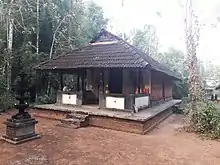Panicker
Panicker was a honorary title conferred by the king of Travancore in kerala to distinguished hindu individuals. Illathu/kiriyathil Nair Panicker were landlords and they were prominent warriors and led the Nair soldiers. They belong to Kshetriya caste. They were well known as the masters of Kalari tradition, having their Nalpatheeradi Kalari (name derived from its area of 42 x 21 feet).[1] They are the people who propagated and practised Kalaripayattu, the martial art form of Kerala. The panicker surname is used by a cluster of communities in Kerala, it is to be noted that Kalari panicker shouldn't be confused with the Nair panicker.
History

Kalaris in Kerala were established during different periods. The formation of Kerala is interlinked with the story of Parashurama. It is believed that Parashurama established 108 kalaris across Kerala.[2] Several kalaris were established during the reign of Kulasekharas.[3] In the 12th century towards the end of Perumal era, the present state of Kerala was divided into small autonomous provinces called Nadus and ruled by its Kings. During the Kulasekhara rule and later the kings of Nadus brought in warriors from Tulu Nadu.
The Portuguese traveller Duarte Barbosa said that "They are the skillful men who teach this art Kalarippayattu, and they are called the Panickers: these are the captains in war."[4] In Journal of the Epigraphical Society of India it, is given that "The teachers of martial arts in order to distinguish themselves from other Panikkars, named themselves as Vanma, Varma Panikkars, Other titles include a middle name of "Kalarikkal" (literally, 'of the kalari') generally following the name of the respective 'kalari' to which he/she belongs to[5][6]
Kalari Panicker is a different caste in Kerala and should not be confused with Nair panicker. The National Commission of Backward Classes lists Kalari Panicker under the list of OBCs.[7] There are also very few families belonging to Christian and Ezhava(Chova) castes who have panicker title, but predominantly it is a Nair title in Kerala
Meloot Panicker
"Meloot is a prominent varma family in kerala (descendant of Chera dynasty ). During their dynasty period, the Meloot family branched themselves into two formations - Ruling authority and Military authority. Henceforth the military authority Meloot Varmas were acknowledged as Panickers (warrior) and upheld the kingdom's shield and administration. [3] Varmas received principal royalty status from The Kingdom of Travancore Since 1827 for their service . They are chiefly known as Meloot Varma Panickers or Meloot Panickers."[8][3] At present , Kalaripayattu is not practiced or followed in some of the Meloot families, yet they keep their tradition and heritage very close to them.
Mathur Panicker
'Mathur' is located in Nedumudi in the Alappuzha district, the home of Mathur Panicker, the Nair General of the Chembakassery King. The Mathur Temple and the Mathur Gallery are there. The place is famous for the arts of Kathakali and Velakali. Kunjan Nambiar stayed at the Mathur temple for Bhajan and offered prayers to Bhagwati. There are Padma Shri award-winning artists including Mathur Govindan Kutty. There is also references to Mathur Panikker in English and Dutch documents. There is existing the pathinaru kettu of Mathur built entirely of wood.
It is to be noted that the last name Panicker can be found in the General and the OBC category. Kalari Panicker is a different ethnic group and is found among the OBC category while the Nair people who use the Panicker title belong to the upper caste/varnas in Kerala. There are also some christians and ezhava/chova communities who have this title. The astronomy community 'kaniyan' also uses this title as kaniyan panicker.
Notable people
- Muloor S. Padmanabha Panicker, Malayalam poet and prominent social reformer
- Achyuta Panikkar, astronomer of Kerala
- Dinesh Panicker, film producer and actor
- Ayyappa Paniker, poet
- G.N.Panicker, literary figure
- K. M. Panikkar (1895–1963), statesman and diplomat, professor, newspaper editor, historian and novelist
- K. N. Panikkar (born 1936), historian
- Kadammanitta Ramakrishnan (born M. R. Ramakrishna Panicker), writer
- Kavalam Madhava Panikkar, diplomat and writer
- Kavalam Narayan Panikkar, dramatist and poet
- Kavalam Narayana Panicker, dramatist, theater director, and poet
- N. Kesava Panikkar, zoologist
- P. K. Narayana Panicker, former General Secretary and President of the Nair Service Society
- P. N. Panicker, father of the Library Movement
- Prem Panicker, cricket journalist
- Puthumana Panicker: Title held by the Padanair( head of army) from Puthumana family[9]
- Chandroth Panicker: Title held by the Padanair from Chandroth family, 15-year-old boy warrior chandroth chanthunni hailed from chandroth family[9]
- Kokat Panicker: Title held by the Padanair from Kokat family[9]
- Verkot Panicker: Title held by the Padanair from Verkot family[10]
- Rahul Panicker, entrepreneur, president and co-founder of Embrace Innovations
- Renji Panicker, journalist, script writer, producer, actor, and director
- Niranam poets:
- Madhava Panikkar, one of the Niranam poets
- Rama Panikkar, one of the Niranam poets
- Sankara Panikkar, one of the Niranam poets
See also Panikkar
References
- "Kalaripayattu".
- Keralolpathi (The origin of Malabar).
- Thampuran ., Ramavarma Appan (1923). Bhootharayar. pp. 86–127.
- Lord Egerton of Tatton (2002). Indian and Oriental Arms and Armour. Courier Dover Publications. p. 80.
- Nossiter, T. J. (Thomas Johnson) (1982). Communism in Kerala : a study in political adaptation. Royal Institute of International Affairs. Berkeley: University of California Press for the Royal Institute of International Affairs, London. ISBN 0-520-04667-6. OCLC 9602086.
- Panikkar, K. M. (July 1918). "Some Aspects of Nayar Life". The Journal of the Royal Anthropological Institute of Great Britain and Ireland. 48: 242–248. doi:10.2307/2843423. ISSN 0307-3114. JSTOR 2843423.
- "National Commission for Backward Classes".
- Sreedhara Menon, A. (2007). A survey of Kerala history. Kerala State, India: D C Books. ISBN 978-81-264-1578-6. OCLC 426093919.
- "മാമാങ്കം: ചോര കൊണ്ടെഴുതിയ വീരചരിത്രങ്ങൾ; പോരാട്ടം, മരണം വരെ". ManoramaOnline (in Malayalam). Retrieved 7 December 2019.
- "Festivals in Ancient Kerala: Mamankam". Kerals.com. 4 March 2016. Archived from the original on 4 March 2016. Retrieved 7 December 2019.